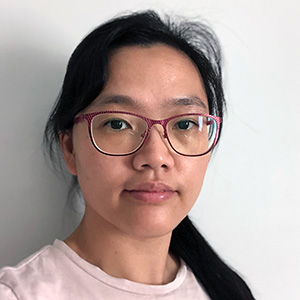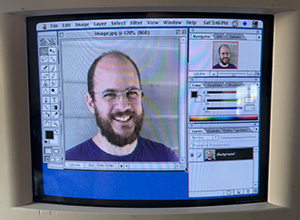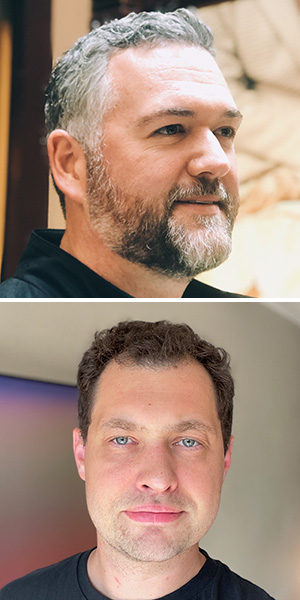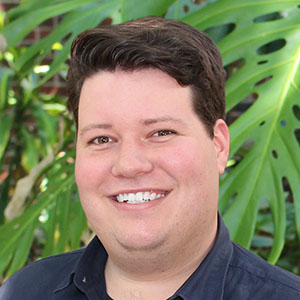![]() This mark indicates that a session recording is available. Click a session title to see more details about that talk and the speaker, and to access the recording.
This mark indicates that a session recording is available. Click a session title to see more details about that talk and the speaker, and to access the recording.
Keynote Speaker
Tim Oliver
How Does it Scale? Writing iOS Code at Instagram
 Long-lived apps at large companies have a whole different raft of challenges than what indie developers might expect. With thousands of engineers contributing code over the years, how does a newcomer to the company even begin to understand any of this, let alone start contributing code? Turns out, it’s easier than you think!
Long-lived apps at large companies have a whole different raft of challenges than what indie developers might expect. With thousands of engineers contributing code over the years, how does a newcomer to the company even begin to understand any of this, let alone start contributing code? Turns out, it’s easier than you think!
This presentation is a top down look at how we develop new features for the Instagram app for iOS, including what sort of architectures and patterns are used in the code, and how the codebase is maintained to keep build times down.
Tim’s been a fanboy of iOS since the iPhone 3G and a fanboy of /dev/world/ since 2010. He currently works as an iOS engineer at Instagram, and before that, at Drivemode, both in Tokyo. In his free time, he enjoys contributing to the open source iOS community, attempting karaoke and playing video games.
Community Sessions
Tap/click each session title for more detail.
 A Journey From Playback to Live Activities
A Journey From Playback to Live Activities
Amy Delves, Delightful Apps
This is a story about an app years in the making. A look at taking an app that was focused on analysing data from existing recordings of data to one that does the recording of data itself. As device capabilities improved and new functionality and frameworks have been added to both iPhones and Apple Watches, their ability to function as recording devices is now at a point where it is viable. So what are the moving parts used to make all this possible? How have Apple's frameworks and devices been used to their fullest potential to make this all a reality? - Bluetooth - connecting to devices such as power / cadence, indoor trainers, radars - SwiftUI - helps to share common UI elements between different targets - Dynamic Island / Live Activities - showing information to the user during the activity This is a story that shows there are a lot of benefits to be gained by leaning heavily on the frameworks and devices provided by Apple.
About the Presenter
A soft and squishy iOS and macOS developer who loves to push the limits of what is possible with Apples frameworks and products. Amy calls Melbourne home though is often found travelling the world. She loves to experience the sights and sounds of different cultures and hear the stories that their people have to tell.
 Building iOS App with Shared GraphQL Schema Across Mutliple Frontend Platforms
Building iOS App with Shared GraphQL Schema Across Mutliple Frontend Platforms
Amy Lin, Seek Ltd
 In your app development, are you on a journey of migrating your networking API to GraphQL? While we are all excited about not being restricted by the API endpoints any more, and having only one schema to be shared among all the frontend platforms, and even the offline experience that GraphQL can provide with the local caching, do you also face some of these challenges?
- While the GraphQL schema seems to work well on web platform, it does not work with your mobile experience.
- You are having no idea what the schema provides. The GraphQL data is difficult to understand.
- When consuming data, each platform requires additional logic.
- Breaking change happens very often and sometimes ends up with production issues.
- Older version apps are always a problem when the GraphQL schema change is deployed.
- Consuming the schema out of the codeGen ended up with a lot of unnecessary guards in the code base and wired syntax in swift.
This talk will cover the best practises for designing GraphQL schema for the app experience. We'll work out the schema design together for a real-life app experience, with some bad designs, and see where the problems are, from structure to fields. By the end of it, hopefully you'll be able to know the principles and practises of schema design and be able to influence how your graphQL schema contract should look like in order to make the best of your app experience, including the older version apps.
In your app development, are you on a journey of migrating your networking API to GraphQL? While we are all excited about not being restricted by the API endpoints any more, and having only one schema to be shared among all the frontend platforms, and even the offline experience that GraphQL can provide with the local caching, do you also face some of these challenges?
- While the GraphQL schema seems to work well on web platform, it does not work with your mobile experience.
- You are having no idea what the schema provides. The GraphQL data is difficult to understand.
- When consuming data, each platform requires additional logic.
- Breaking change happens very often and sometimes ends up with production issues.
- Older version apps are always a problem when the GraphQL schema change is deployed.
- Consuming the schema out of the codeGen ended up with a lot of unnecessary guards in the code base and wired syntax in swift.
This talk will cover the best practises for designing GraphQL schema for the app experience. We'll work out the schema design together for a real-life app experience, with some bad designs, and see where the problems are, from structure to fields. By the end of it, hopefully you'll be able to know the principles and practises of schema design and be able to influence how your graphQL schema contract should look like in order to make the best of your app experience, including the older version apps.
About the Presenter
Amy is senior iOS developer working at SEEK, passionate about solving problems with clean code, and an advocator for best practises and fostering a clean code culture. In the past few years, Amy has migrated a number of networking APIs to GraphQL in the SEEK iOS app. Last year, Amy led a mobile app development team that migrated a six-year-old legacy component to GraphQL across Android, iOS and Web platforms.
 Life @ BigTechCo
Life @ BigTechCo
Andyy Hope
 We've seen a lot of our friends and colleagues move to the US in the past few years and for a lot of people, it's their dream (it was mine, at least) to make the jump work at one of the big tech companies.
This talk will cover what it's like to work at a large tech company and how it can be so different from the usual Apple dev role in Australia/NZ. My talk will cover the pros, cons and differences of working at these companies and give the audience a good insight on what to expect if they ever decide to make the big move across the Pacific Ocean. It will also cover a lot of the benefits of working in Australia in comparison and I'll discuss some of my reasons for moving back.
We've seen a lot of our friends and colleagues move to the US in the past few years and for a lot of people, it's their dream (it was mine, at least) to make the jump work at one of the big tech companies.
This talk will cover what it's like to work at a large tech company and how it can be so different from the usual Apple dev role in Australia/NZ. My talk will cover the pros, cons and differences of working at these companies and give the audience a good insight on what to expect if they ever decide to make the big move across the Pacific Ocean. It will also cover a lot of the benefits of working in Australia in comparison and I'll discuss some of my reasons for moving back.
About the Presenter
My name is Andyy Hope, you may know me from my Apple dev conference in 2017, Playgrounds Conference. Since Playgrounds, I've had the opportunity to experience working at a couple of the familiar big tech companies, Meta (previously known as Facebook) and Twitter.
The Road to Swift 6
Ashton Williams, SEEK
Swift as a language just keeps on growing. Even with a transparent evolution process, and an official yearly conference covering the changes. Are you still a bit lost on what has changed in the last year? You are not alone. Whether you are a beginner or a code warrior, understanding these additions to the language is not always easy. I bet you'd really like to know if and how they can help you write better code. Let's demystify those complex sounding concepts such as existential types, opaque result types, primary associated types, and more. Then let's explore what we learn applying them in real world projects. You’ll take away an understanding of some new Swift concepts, and the vocabulary to understand future swift evolution proposals. Some prior knowledge of Swift is recommended to get the most out of this talk.
About the Presenter
Ashton is a Staff Engineer at SEEK, based in Melbourne. He is obsessed with iOS development and has a large collection of Apple chargers and cables. You might remember him from past /dev/world/ conferences or the local community. Although you probably haven't seen him lately.
 How to Improve as a Developer Without Writing New Code
How to Improve as a Developer Without Writing New Code
Gio Lodi, Automattic
Software developers write code for a living, but there is more that goes into shipping software than writing its code. And while diving deep into programming language or framework is a great way to improve one's craft, there are other, often more effective, ways to improve that do not require writing code. This talks shares a set of techniques for leveling up as a software developer across three areas: The work. The not-work. The team-work. For each area, three techniques are provided. The aim of the talk is to broaden the audience's perspective on what it takes to "be productive", and to arm them with new tools to deploy at work. The talk doesn't want to be prescriptive, but rather informative and inspiring.
About the Presenter
Gio is a mobile infrastructure engineer working remotely with Automattic, the makers of WordPress.com, Tumblr, Pocket Casts, and more. He writes about software and productivity at https://giolodi.com and recently published Test-Driven Development in Swift with Apress. When he's not working or spending time with his kids, you'll likely find him reading or practicing to reach "sub-30" on the 3x3 Rubik's cube.
 Building Thoughtful ML Experiences: User-Centered Machine Learning Applications
Building Thoughtful ML Experiences: User-Centered Machine Learning Applications
James Dale, Friday Technologies
 In recent years, machine learning has become crucial in shaping how we interact with devices and services. However, building machine learning applications that prioritize the needs and privacy of users can be a complex and challenging task. This talk will explore how to use Core ML and Create ML to develop user-centred machine learning experiences using Apple platforms. We will focus on the advantages of using on-device machine learning, including speed and privacy benefits over cloud-based approaches. We will also discuss making machine learning accessible and inclusive for all users, regardless of technical background. Additionally, we will delve into privacy in machine learning and how to design applications that respect user data and maintain trust. Join us to discover how to build thoughtful and user-centred machine-learning experiences for Apple platforms.
In recent years, machine learning has become crucial in shaping how we interact with devices and services. However, building machine learning applications that prioritize the needs and privacy of users can be a complex and challenging task. This talk will explore how to use Core ML and Create ML to develop user-centred machine learning experiences using Apple platforms. We will focus on the advantages of using on-device machine learning, including speed and privacy benefits over cloud-based approaches. We will also discuss making machine learning accessible and inclusive for all users, regardless of technical background. Additionally, we will delve into privacy in machine learning and how to design applications that respect user data and maintain trust. Join us to discover how to build thoughtful and user-centred machine-learning experiences for Apple platforms.
About the Presenter
James Dale is an entrepreneur and developer specialising in iOS App Development. Currently, he is leading App Development studio, Friday Technologies. Previously, he cofounded US-based startup HAGS, backed by Google and BoxGroup (now acquired by Snapchat). James is the recipient of four Apple WWDC Scholarship awards, and a serial iOS app developer creating apps such as CleanSky and RulAR. He previously worked at Apple in the ISE Special Projects and Machine Learning Platform & Technology teams, contributing to the Create ML framework and macOS app. James speaks often at iOS and Swift industry conferences, and teaches online Swift courses with RMIT University. James is driven to create change in the mobile apps and machine learning spaces! Keep up to date with James on Twitter at @_JamesDale.
 What Do You Do With All These Old Computers Anyway?
What Do You Do With All These Old Computers Anyway?
Josh Deprez
 I accumulate old Macintoshes, and they all suck. Compared with a commodity iPhone or iPad, they are vastly inferior and incapable, they're filled with heavy metals, they don't consume any less electricity than their modern counterparts, and the software and hardware is difficult to interface with the modern world.
At least if I sell out, I could expect high sale prices!
Aside from getting nostalgia hits, and admiring the aesthetics (the Power Mac G4 Cube is in the collection of the Museum of Modern Art, after all), what are these paleolithic computers good for?
The answers, and more, might be presented in this talk!
I accumulate old Macintoshes, and they all suck. Compared with a commodity iPhone or iPad, they are vastly inferior and incapable, they're filled with heavy metals, they don't consume any less electricity than their modern counterparts, and the software and hardware is difficult to interface with the modern world.
At least if I sell out, I could expect high sale prices!
Aside from getting nostalgia hits, and admiring the aesthetics (the Power Mac G4 Cube is in the collection of the Museum of Modern Art, after all), what are these paleolithic computers good for?
The answers, and more, might be presented in this talk!
About the Presenter
Josh is running out of time for the CFP, but they hope they can write a more complete bio and ship it later.
Let’s Talk About Sec, Baby
Louis Cremen, Lumify Work
It’s 2023. Cyber attacks are all over the news. Your managers, and their managers have seen data breaches and ransomware in other organisations and they are asking the question: “Do we have security baked into our app?” You’re an excellent developer, of course you’ve done best practices that you know of. But then they ask the next question: “what assurances can you give that we are not going to be susceptible to a data breach”... and that’s where the expertise finishes for most developers - so this talk will prepare you to go over that line and prepare you for the next phase of Secure Software Development. Join Louis as he brings humour, case studies and resources to help you build security into your mind, into your pipelines and into your heart.
About the Presenter
Louis is a cybersecurity instructor for Lumify and works closely with stakeholders to implement the strategic growth and direction of the Cybersecurity category of training and education programs within Lumify and is involved in the Cyber upskilling training and education of cybersecurity professionals using certifications from vendors such as (ISC)², ISACA, EC Council, CompTIA for clients including ASX 100 companies, Federal and State Government, Defence, Local law enforcement and SMEs. He’s the lead trainer for CISSP, CISM, CISA, CRISC, CEH, Security+, Cyber Secure Coder and CSSLP. He has worked with local and international government agencies and businesses as a security professional and as a software engineer helping bring products to market, and securing the software development life cycle. He started his career as an iPhone app developer on the first day Apple released the iPhone Software Development Kit; he later built his own software company from it going on to make award-winning security software testing solutions for international governments. He has now pivoted into the world of information security, but his heart still beats as a developer. Louis greatest personal achievements are his family - his wife and three young kids - who are passionate about learning and playing - exactly as he would want them to be ? . His long term trajectory is to get into neuro-technology, understanding and enhancing the brain and the human with it. He's on track to finish his Neuroscience graduate certificate this year (hopefully by July!) If you want to talk about security, brains, development, Apple, ChatGPT, or really anything - feel free to say hi at the conference or connect on LinkedIn :).
 Introduction to Backend Development
Introduction to Backend Development
Sam Jarman, Cochlear
 Backend Programming, Cloud Programming, Server side programming can be quite the mysterious enigma for an iOS developer. However, sometimes you might need a server component to your application. I've found there's a lot to cover when learning about the cloud, so this talk pulls together a few key concepts you'll need to know to get started. These concepts include the request-response loop, background processing, queues and streams, DNS, hosting, frameworks and cloud providers. This is an introductory level talk with only basic programming examples required - so this should be suitable to follow for any experience level.
Backend Programming, Cloud Programming, Server side programming can be quite the mysterious enigma for an iOS developer. However, sometimes you might need a server component to your application. I've found there's a lot to cover when learning about the cloud, so this talk pulls together a few key concepts you'll need to know to get started. These concepts include the request-response loop, background processing, queues and streams, DNS, hosting, frameworks and cloud providers. This is an introductory level talk with only basic programming examples required - so this should be suitable to follow for any experience level.
About the Presenter
Sam Jarman is a Principal Cloud Engineer at Cochlear. Originally from Christchurch, New Zealand, he is a skilled developer with a passion for coding and sharing his knowledge with others. He has experience working as an iOS developer, but currently focuses on backend development. He is known for giving talks, writing blog posts and mentoring others in the tech community.
 Swift, Serverside, Serverless
Swift, Serverside, Serverless
Sebastien Stormacq, AWS
 Swift developers have many options to deploy their server-side code. But did you consider serverless, with no server to manage or to scale by yourself, and only paying for actual usage?
In this talk I will show you how to deploy your server-side Swift applications on AWS Lambda. I'll start with a traditional Vapor app running unmodified in the cloud. Then we will deploy a native Swift Lambda function using the open source Lambda Swift runtime and a deployer SPM plugin.
Swift developers have many options to deploy their server-side code. But did you consider serverless, with no server to manage or to scale by yourself, and only paying for actual usage?
In this talk I will show you how to deploy your server-side Swift applications on AWS Lambda. I'll start with a traditional Vapor app running unmodified in the cloud. Then we will deploy a native Swift Lambda function using the open source Lambda Swift runtime and a deployer SPM plugin.
About the Presenter
Seb is writing code since he first touched a Commodore 64 in the mid-eighties. He is inspiring builders to unlock the value of the AWS cloud, using his secret blend of passion, enthusiasm, customer advocacy, curiosity and creativity. His interests are about software architectures, developer tools and mobile computing. Seb is a blogger on AWS News Blog (aka Jeff’s blog), a keynote speaker at AWS Summit, a regular speaker at conferences, the host of the official AWS ?? Podcast, the AWS Video Channel in french, and a regular contributor to Les technos ?? podcast (in french). Before joining the AWS Evangelist team, Seb built & lead the AWS technical training team in EMEA, and the Alexa solution architecture team in UK, France, Italy and Spain. If you want to sell him something, be sure it has an API.
 Bridging the Accessibility Gap
Bridging the Accessibility Gap
Tony Arnold & Chris Kolbu, Itty Bitty Apps
 The *accessibility gap* is the gap between having a passing familiarity with the accessibility APIs, and being able to wield them effectively to create great accessible experiences.
Accessibility has been a focus for Reveal for the last few years, and our work has been motivated by wanting to help developers and mobile teams close this gap.
Most accessibility advice online starts from the bottom, assuming no prior knowledge, and will often include lengthy justifications for *why* you should make your app accessible.
We’re going to assume you already recognise and respect why it’s important that your app is accessible to as many users as possible.
Using Reveal's Accessibility and Insights workspaces, we'll go through a real-world app and show how choices affect the accessible user interfaces differently, and how to create a better experience, using concrete, actionable examples.
The goal is for you to leave this talk with approaches and tools that you can apply to your own apps.
The *accessibility gap* is the gap between having a passing familiarity with the accessibility APIs, and being able to wield them effectively to create great accessible experiences.
Accessibility has been a focus for Reveal for the last few years, and our work has been motivated by wanting to help developers and mobile teams close this gap.
Most accessibility advice online starts from the bottom, assuming no prior knowledge, and will often include lengthy justifications for *why* you should make your app accessible.
We’re going to assume you already recognise and respect why it’s important that your app is accessible to as many users as possible.
Using Reveal's Accessibility and Insights workspaces, we'll go through a real-world app and show how choices affect the accessible user interfaces differently, and how to create a better experience, using concrete, actionable examples.
The goal is for you to leave this talk with approaches and tools that you can apply to your own apps.
About the Presenter
Chris Kolbu is a senior iOS/macOS developer at Itty Bitty Apps. He cares deeply about accessibility, user and developer experience, software testing, and performance. He does not care for Christmas being in summer, but is getting used to it. Tony Arnold has been developing for Apple’s platforms for over 20 years, and leads the delivery of Reveal at Itty Bitty Apps. Tony and Chris are the current developer team behind Reveal, a development tool used to debug and improve apps on Apple’s mobile platforms for almost a decade.
 Highs and Lows of Teaching SwiftUI
Highs and Lows of Teaching SwiftUI
Tristan Reed, Curtin University
 With SwiftUI clearly here to stay and in awe of its power, capabilities and simplicity, Tristan W. Reed and David A. McMeekin decided to adapt the content of their existing “Introduction to iOS Development" MOOC to SwiftUI (where possible) when adapting the MOOC as an internal undergraduate unit at Curtin University. Tristan will speak about some of the issues encountered in adapting the course for SwiftUI, considering different devices, alongside some of the benefits from both the perspective of the educators and from the perspective of the students themselves - including benefits with using non-Apple frameworks!
With SwiftUI clearly here to stay and in awe of its power, capabilities and simplicity, Tristan W. Reed and David A. McMeekin decided to adapt the content of their existing “Introduction to iOS Development" MOOC to SwiftUI (where possible) when adapting the MOOC as an internal undergraduate unit at Curtin University. Tristan will speak about some of the issues encountered in adapting the course for SwiftUI, considering different devices, alongside some of the benefits from both the perspective of the educators and from the perspective of the students themselves - including benefits with using non-Apple frameworks!
About the Presenter
Tristan W. Reed is an academic at Curtin University, a software engineer who enjoys utilisting and teaching Apple tools and frameworks to others as well as use software technologies to solve problems in the real world.

